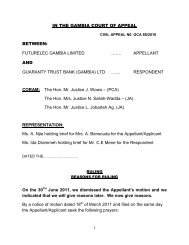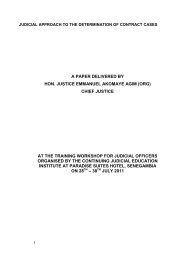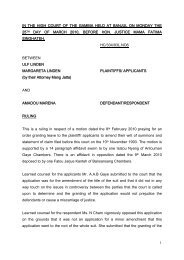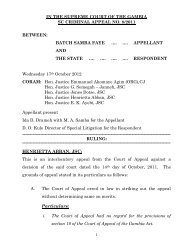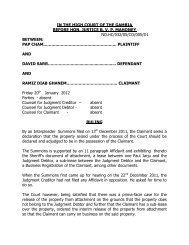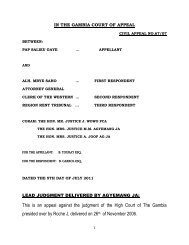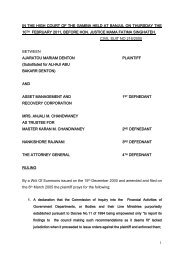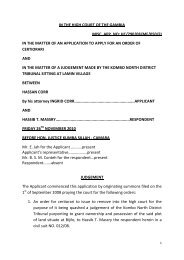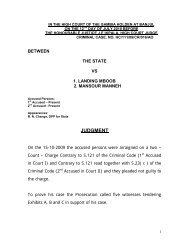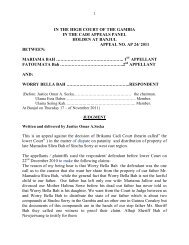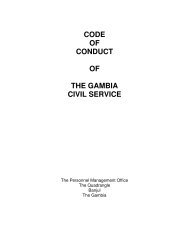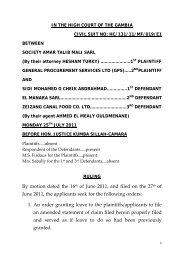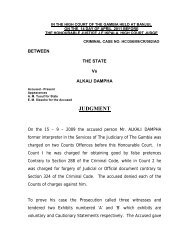Judgment The State vs Dr Amadou Scattred Janneh and Ors
Judgment The State vs Dr Amadou Scattred Janneh and Ors
Judgment The State vs Dr Amadou Scattred Janneh and Ors
You also want an ePaper? Increase the reach of your titles
YUMPU automatically turns print PDFs into web optimized ePapers that Google loves.
IN THE HIGH COURT OF THE GAMBIA<br />
CRIMINAL CASE No: HC/323/11/CR/101/AO<br />
BETWEEN:<br />
THE STATE<br />
COMPLAINANT<br />
VS.<br />
DR. AMADOU SCATTRED JANNEH<br />
MODOU KEITA<br />
EBRIMA JALLOW<br />
MICHEAL C. UCHE THOMAS<br />
1 st ACCUSED<br />
2 nd ACCUSED<br />
3 rd ACCUSED<br />
4 th ACCUSED<br />
TUESDAY 17 th JANUARY 2012<br />
BEFORE HON. JUSTICE EMMANUEL A. NKEA<br />
1 st ACCUSED PRESENT<br />
2 nd ACCUSED PRESENT<br />
3 rd ACCUSED PRESENT<br />
4 th ACCUSED PRESENT<br />
MR. M. ABDOULAHI (DPP), MR. S.H BARKUN (DDPP), MRS. A. D<br />
BWALA (SSC) & Ms S. SANKARY (SC) FOR THE STATE<br />
MR. L.S. CAMARA FOR ALL ACCUSED PERSONS<br />
JUDGMENT<br />
<strong>The</strong> accused persons st<strong>and</strong> charged with four (4) counts, pursuant to the<br />
consent of the Honourable Attorney General of <strong>The</strong> Gambia, given on the<br />
18 th of July, 2011 as required by Section 39 of the Criminal Code, Cap 10<br />
Vol. III Revised Laws of <strong>The</strong> Gambia 2009 as follows:<br />
COUNT I:<br />
1
STATEMENT OF OFFENCE<br />
Conspiracy to commit treason, contrary to section 35 (1) (g) of the Criminal<br />
Code, Cap 10 Vol. III Revised Laws of <strong>The</strong> Gambia, 2009<br />
PARTICULARS OF OFFENCE<br />
<strong>Dr</strong>. <strong>Amadou</strong> <strong>Scattred</strong> <strong>Janneh</strong> on or about the 26 th day of May 2011 in<br />
diverse places in the Republic of <strong>The</strong> Gambia <strong>and</strong> elsewhere, conspired<br />
with Ndey Tapha Sosseh, Mathew K. Jallow, Famara Demba <strong>and</strong> others at<br />
large to overthrow the Government of <strong>The</strong> Gambia by unlawful means <strong>and</strong><br />
thereby committed an offence.<br />
COUNT II:<br />
STATEMENT OF OFFENCE<br />
Treason contrary to section 35 (1) (a) of the Criminal Code, Cap 10 Vol. III<br />
Revised Laws of <strong>The</strong> Gambia 2009<br />
PARTICULARS OF OFFENCE<br />
<strong>Dr</strong>. <strong>Amadou</strong> <strong>Scattred</strong> <strong>Janneh</strong>, Ndey Tapha Sosseh, Mathew K. Jallow,<br />
Famara Demba <strong>and</strong> at large on or about the 26 th day of May 2011 in diverse<br />
places in the Republic of <strong>The</strong> Gambia <strong>and</strong> elsewhere prepared to<br />
overthrow the Government of <strong>The</strong> Gambia by unlawful means <strong>and</strong> thereby<br />
committed an offence.<br />
COUNT III:<br />
STATEMENT OF OFFENCE<br />
Seditious act contrary to section 52 (1) (a) of the Criminal Code, Cap 10 Vol.<br />
III Revised Laws of <strong>The</strong> Gambia 2009<br />
PARTICULARS OF OFFENCE<br />
2
<strong>Dr</strong>. <strong>Amadou</strong> <strong>Scattred</strong> <strong>Janneh</strong>, Modou Keita, Ebrima Jallow, Micheal C.<br />
Uche Thomas <strong>and</strong> others at large on or about the 26 th day of May 2011 in<br />
diverse places in the Republic of <strong>The</strong> Gambia conspired amogst yourselves<br />
to print <strong>and</strong> distribute 100 T-shirts carrying seditious statements to wit:<br />
coalition for change <strong>The</strong> Gambia, end dictatorship now, <strong>and</strong> thereby<br />
committed an offence.<br />
COUNT IV:<br />
STATEMENT OF OFFENCE<br />
Seditious act contrary to section 52 (1) (c) of the Criminal Code, Cap 10 Vol.<br />
III Revised Laws of <strong>The</strong> Gambia 2009<br />
PARTICULARS OF OFFENCE<br />
<strong>Dr</strong>. <strong>Amadou</strong> <strong>Scattred</strong> <strong>Janneh</strong>, Modou Keita, Ebrima Jallow, Micheal C.<br />
Uche Thomas <strong>and</strong> others at large on or about the 26 th day of May 2011 in<br />
diverse places in the Republic of <strong>The</strong> Gambia with intent to cause or bring<br />
into hatred, contempt or to excite disaffection against the person of the<br />
President or the Government of <strong>The</strong> Gambia printed <strong>and</strong> distributed 100 T-<br />
shirts carrying seditious statements to wit: coalition for change <strong>The</strong><br />
Gambia, end dictatorship now, <strong>and</strong> thereby committed an offence.<br />
On the 19 th of July 2011, the accused persons all pleaded not guilty to the<br />
various counts against them.<br />
<strong>The</strong> Prosecution called fourteen (14) witnesses in all, in an attempt to prove<br />
their case. At the close of the prosecution’s case, the defence elected to rest<br />
their case on that of the prosecution. As such no evidence was led by the<br />
accused persons in their defence. I will return to this issue latter.<br />
3
<strong>The</strong> case of the prosecution as elicited in the testimonies of the prosecution<br />
witnesses is that, on or about the 26 th day of May 2011, whilst PW2<br />
(Sulayman Gaye) was walking along Kairaba Avenue, <strong>and</strong> as he got to a<br />
point near the Post Office junction, a vehicle with a yellow colour <strong>and</strong><br />
white background drove pass him in top speed <strong>and</strong> a plastic bag<br />
containing a T-Shirt was thrown out from the moving vehicle. <strong>The</strong> plastic<br />
bag was picked up by PW2 <strong>and</strong> when he opened it later, he found that the<br />
T-shirt had the words “Coalition for Change <strong>The</strong> Gambia” End<br />
Dictatorship Now” written on the front while the word “Freedom” was<br />
written on the back. <strong>The</strong>se words according to PW2 are capable of inciting<br />
contempt, hatred <strong>and</strong> disaffection against the democratically elected<br />
government of <strong>The</strong> Gambia <strong>and</strong> the person of the President. <strong>The</strong> T-Shirt<br />
which was thrown out from the moving vehicle is in evidence as exhibit<br />
“A3”. PW2 took the T-Shirt to his office at the Police Head Quarters the<br />
next day <strong>and</strong> presented same to his seniors who found it to be offensive. A<br />
panel was instituted to investigate the matter. Unable to track down the<br />
vehicle from which the T-shirt was thrown out, the panel detailed some of<br />
it members to visit the Albert Market in Banjul with a view to identify any<br />
businessman dealing in such T-shirts. <strong>The</strong>ir investigation took them to the<br />
shop of PW3 Mohammed Idriss who identified exhibit “A3” from its trade<br />
mark ‘soft comfort’ as part of the 100 T-Shirts he had sold to the 4 th<br />
accused. More T-Shirts of the same colour <strong>and</strong> with the same words<br />
printed on them were later recovered from PW1, PW10 <strong>and</strong> the 1 st accused.<br />
<strong>The</strong>se other T-Shirts are in evidence as exhibits “A, A1, A2, A4, A5” <strong>and</strong><br />
4
“DE3”. More of these T-shirts were also distributed by the 1 st accused to<br />
PW4, <strong>and</strong> PW5 who are both staffs of Commit Enterprises.<br />
<strong>The</strong> 4 th accused was later on arrested <strong>and</strong> he admitted having printed<br />
exhibit “A3”. His residence was searched where the films used in printing<br />
the words <strong>and</strong> the logo on the T-shirts was recovered; these two films are<br />
in evidence as exhibits “D-D1” respectively. He led the investigators to the<br />
2 nd <strong>and</strong> 3 rd accused as the persons who had given him the contract to print<br />
the T-shirts. <strong>The</strong> 2 nd <strong>and</strong> 3 rd accused persons in turn led the police to the 1 st<br />
accused as the person who contracted them to print the T-shirts.<br />
<strong>The</strong> police visited the 1 st accused at his ‘Commit’ business premises located<br />
opposite the Fire Station at Kotu, where the police identified <strong>and</strong> recovered<br />
the vehicle from which the T-shirt exhibit “A3” was thrown out. <strong>The</strong><br />
vehicle is in evidence as exhibit “C” whilst the ignition key is in evidence<br />
as “C1”. In order to determine the real owner of the vehicle, a letter was<br />
written by PW13 to the Vehicle Licensing Unit of the Gambia Police Force<br />
requesting information as to the owner of the said vehicle. In response the<br />
Vehicle Licensing Unit confirmed the vehicle to be the property of the 1 st<br />
accused. <strong>The</strong> letter of request <strong>and</strong> the reply thereto are in evidence as<br />
exhibits “H5” <strong>and</strong> “H6” respectively. An external hard drive (exhibit “B”)<br />
was also recovered from the office of the 1 st accused. When exhibit “B” was<br />
connected onto a computer, an audio interview with the Secretary General<br />
of Coalition for Change <strong>The</strong> Gambia (hereinafter CCTG or CCG); Ndey<br />
Tapha Sosseh <strong>and</strong> an audio press release from the CCTG were found<br />
therein. <strong>The</strong> audio interview <strong>and</strong> audio press release were downloaded<br />
5
<strong>and</strong> later transcribed by PW7. <strong>The</strong> transcribed version of the audio<br />
interview <strong>and</strong> press release is in evidence as exhibit “D2”. <strong>The</strong> audio<br />
interview was, according to PW7, to be sent to SUD FM, Kaolack, Senegal<br />
for broadcast.<br />
<strong>The</strong> objectives of the CCTG, according to PW7 <strong>and</strong> PW13, were to remove<br />
President Jammeh from office by wearing the T-shirts <strong>and</strong> going on street<br />
demonstrations as it happened in some North African countries recently.<br />
<strong>The</strong> CCTG intended to carry out this plan on African Liberation Day (25 th<br />
May, 2011), which is also the birth day of President Jammeh. <strong>The</strong> CCTG<br />
made contacts with some senior Senegalese politicians requesting for the<br />
support of Senegalese authorities to their campaign. In this regard, the 1 st<br />
accused wrote <strong>and</strong> sent an email message to Doudou Wade, <strong>The</strong> Majority<br />
Leader of the Senegalese National Assembly, thanking him for having<br />
accorded them audience <strong>and</strong> requesting him to fix an appointment<br />
between the CCTG <strong>and</strong> other senior politicians <strong>and</strong> civil servants in<br />
Senegal. This particular email which was written in French is found at page<br />
twenty six (26) of exhibit “D3”. <strong>The</strong> email was translated into English<br />
language by PW12 <strong>and</strong> the translated version admitted in evidence as<br />
exhibit “H4”.<br />
During the course of the investigations, the 1 st accused was requested to<br />
open up his personal email account – webjula@hotmail.com for inspection<br />
by PW13. When the 1 st accused did, a username <strong>and</strong> password of CCTG<br />
was found therein. PW7 described the username <strong>and</strong> the password found<br />
therein as ccgtg411@gmail.com <strong>and</strong> april411 respectively. All members of<br />
6
the CCTG shared <strong>and</strong> used the same username <strong>and</strong> password to log into<br />
the CCTG email account in their communication with each other.<br />
According to PW7, negative email conversations between the 1 st accused<br />
<strong>and</strong> other members of the CCTG were also found in the email account of<br />
the CCTG which were extracted <strong>and</strong> printed out. <strong>The</strong> email printouts were<br />
admitted in evidence as a bundle as exhibit “D3”. <strong>The</strong> subject line of some<br />
of the email printouts includes amongst others: (a) CCTG Account Details<br />
<strong>and</strong> T-Shirt Printed in <strong>The</strong> Gambia; (b) Logo; (c) Notification of Donations;<br />
<strong>and</strong> (d) Notification of Transmitters Purchased from eBay. An email from<br />
eBay confirming the purchase of the transmitter listed in (d) above was<br />
sent to the 1 st accused through his email account gmcommit@aol.com. This<br />
particular email is found at page four (4) of exhibit “D3”.<br />
In the course of the investigations, the accused persons made statements to<br />
the police. <strong>The</strong> 1 st accused person made two cautionary <strong>and</strong> three<br />
voluntary statements to PW8. <strong>The</strong>se statements are in evidence as exhibits<br />
“E, E1, E2, E3, <strong>and</strong> E4”. <strong>The</strong> two cautionary statements were written by the<br />
1 st accused himself. On his part, the 2 nd accused made one cautionary <strong>and</strong><br />
two voluntary statements which are in evidence as exhibits “F, F1 <strong>and</strong> F2”.<br />
<strong>The</strong> cautionary <strong>and</strong> voluntary statements of the 3 rd accused which were<br />
recorded by PW9 are in evidence as exhibits “G-G1” respectively. On his<br />
part the 4 th accused made one cautionary <strong>and</strong> two voluntary statements.<br />
<strong>The</strong>se statements are in evidence as exhibits “H, H1 <strong>and</strong> H2” <strong>and</strong> like the<br />
1 st accused, the 4 th accused wrote exhibit “H”; his cautionary statement,<br />
himself. While exhibits H7a <strong>and</strong> H7b are the pictures of 1 st accused<br />
7
etrieving exhibit “A” from the book shelf in his office, exhibits H8a <strong>and</strong><br />
H8b are pictures of the 1 st accused at his residence with the t-shirts. Exhibit<br />
“J” on the other h<strong>and</strong> is the CDR print out from Comium on the number<br />
6161981 ascribed to the 1sts accused.<br />
<strong>The</strong>se are the brief facts of the case.<br />
Both sides filed <strong>and</strong> adopted written briefs before me. In his brief of<br />
argument before me, the learned DPP has formulated five (5) issues for<br />
determination as follows:<br />
(1) Whether the ingredients of the offence of conspiracy to commit<br />
treason contrary to section 35 (1) (g) of the Criminal Code has been<br />
made out <strong>and</strong> proved against the 1 st accused as required by law.<br />
(2) Whether the ingredients of the offence of treason contrary to<br />
section 35 (1) (a) of the Criminal Code has been made out <strong>and</strong><br />
proved against the 1 st accused as required by law.<br />
(3) Whether there is corroboration as required by section 38 of the<br />
Criminal Code.<br />
(4) Whether the ingredients of the offence of Seditious Act contrary to<br />
section 52 (1) (a) <strong>and</strong> 52 (1) (c) of the Criminal Code has been made<br />
or proved as required by law.<br />
(5) Whether there is corroboration as required by section 58 of the<br />
Criminal Code.<br />
Although the above issues capture the thrust of the matters to be<br />
determined in this case, I have, however, chosen to formulate the issues for<br />
8
determination count by count. I will return to the issues for determination<br />
when I deal with each count of the offences under charge.<br />
I will now proceed with the evaluation of the evidence on record to<br />
determine whether the prosecution has proved its case or not. However,<br />
before doing so, <strong>and</strong> as a preliminary issue, I will like to take off sometime<br />
to dwell on a seemingly new trend in criminal trials in this Court whereby<br />
the accused persons refuse to call evidence in defence <strong>and</strong> rather choose to<br />
rest its case on that of the prosecution, <strong>and</strong> regrettably so, in capital offence<br />
cases. It happened before; in the case of THE STATE V. LT. GEN<br />
LANGTOMBONG TAMBA & ANOR (HC/333/10), before Ikpala J; it<br />
happened again in THE STATE V. EBOU LOWE & ANOR (HC/267/11)<br />
before me, <strong>and</strong> now again in this matter. In addressing this strategy of the<br />
defence, the points, which fall for determination as far as this issue is<br />
concern, are:<br />
(a) What is the foundation <strong>and</strong> legal effect of the right of an accused<br />
person not to give evidence on oath?<br />
(b) What is the legal implications of (a) above? Or what does it imply,<br />
when such accused rests his case on that of the prosecution?<br />
(c) When is it proper for the defence to rest its case on that of the<br />
prosecution?<br />
I am aware of, <strong>and</strong> I recognize the right of an accused person, to remain<br />
silent throughout the trial, leaving the burden of proof of his guilt beyond<br />
reasonable doubt, to the prosecution. See UTTEH & ANOR V. THE STATE<br />
9
(1992) 2 SCNJ (Pt.1) 183 at 194. In other words, an accused person is<br />
presumed innocent, until he is proven guilty. <strong>The</strong>re is therefore, no<br />
question of his proving his innocence. This is because, for the duration of a<br />
trial, an accused person is not bound to say anything. He may not utter a<br />
word. <strong>The</strong> duty is on the prosecution, to prove the charge against him, <strong>and</strong><br />
as I have said, beyond reasonable doubt. See the case of UCHE WILLIAMS<br />
V. THE STATE (1992) 10 SCNJ 74 at 80. <strong>The</strong> right of silence is founded <strong>and</strong><br />
covered by the 1997 Constitution of <strong>The</strong> Gambia. Section 24 (8) of the<br />
Constitution (of <strong>The</strong> Gambia, 1997) provides that “no person charged with<br />
a criminal offence shall be compelled to give evidence at the trial”. It is<br />
therefore the constitutional right of the accused persons to remain silent.<br />
Generally in criminal trials three alternatives are opened to an accused<br />
person after the prosecution has closed its case. <strong>The</strong> accused may: (a) make<br />
an unsworn statement from the dock in which case he will not be liable to<br />
be cross-examined, or (b) he may give sworn evidence in the witness box<br />
<strong>and</strong> be cross-examined, or (c) he may elect not to say anything at all.<br />
In the instant case the defence choosed the third alternative <strong>and</strong> they were<br />
well within their legal rights to do so. <strong>The</strong> legal effect of this is that, if in the<br />
course of the hearing, prosecution witnesses had given evidence which<br />
called for rebuttal or some explanation from the accused person (s), <strong>and</strong><br />
that rebuttal <strong>and</strong>/or explanation was not forthcoming, then the Court<br />
would be free to accept the un-contradicted evidence of the prosecution.<br />
<strong>The</strong> defence has in effect, therefore, shut it-self out. Where an accused<br />
person opts not to testify <strong>and</strong> rests his case on that of the prosecution as in<br />
10
the instant case, <strong>and</strong> the prosecution has by credible evidence of its witness<br />
or witnesses, proved its case beyond reasonable doubt, then, he will have<br />
himself to blame.<br />
With regard to the second question posed above, what does it mean when<br />
an accused rests his case on that of the prosecution? In my view, it means<br />
no more than that the accused does not wish to place any facts before the<br />
Court other than those, which the prosecution had presented in evidence. It<br />
also signifies that the accused is satisfied with the evidence given <strong>and</strong> does<br />
not wish to explain any fact or rebut any allegations made against him. It<br />
also implies that the court will not be expected to speculate on what the<br />
accused person might have said. See the case of ALI & ANOR V. THE<br />
STATE (1988) 1 SCNJ. 17.<br />
With regards to third question above; on the propriety of the defence<br />
resting its case on that of the prosecution, I will like to state that “in a<br />
criminal trial, a defence counsel would be safe in resting his case on the<br />
prosecution's case if he succeeds in discrediting the prosecution's witnesses<br />
by cross-examination to such an extent that the court would find it difficult<br />
to convict the accused persons”. See the case of FATILEWA V. THE STATE<br />
(2007) ALL FWLR (Pt. 347) 695 at 722.<br />
From the above, it seems to me that it should not be a gamble to rest the<br />
defence case on that of the prosecution. It should be a well thought out<br />
plan based on the weight of evidence adduced <strong>and</strong> the nature of the<br />
offence. It is a big risk because issues of fact will have to be decided in<br />
11
favour of an accused person based on the evidence adduced against him.<br />
<strong>The</strong> risk involved in taking such a stance is the type eloquently highlighted<br />
by the Privy Council in the case of THE QUEEN V. SHARMPAL SINGH<br />
(1962) 2 WLR 238 at 243 - 245.<br />
Thus, in the case of BABALOLA & ORS V. THE STATE (1989) 4 NWLR (Pt.<br />
115) 264 at 276; the Supreme Court of Nigeria cautioned that whereas<br />
prudence dictates that an accused person should not assist the prosecution<br />
which has failed to prove every material ingredient in the case against him,<br />
it is a reckless hazard to insist on the exercise of that right when the<br />
prosecution has made a prima facie case which calls for the accused<br />
person’s explanation. I must add that, where a prima facie case has been<br />
made out in a capital offence trial such as the instant one, it may not only<br />
be alarming <strong>and</strong> suicidal, but also grossly inhuman, on the part of counsel<br />
to elect to rest the defence case on that of the prosecution.<br />
I will now turn to the charges before this Court, <strong>and</strong> in so doing; I shall<br />
consider Count II first.<br />
In Count II, the 1 st accused person is charged with preparing to overthrow<br />
the government of <strong>The</strong> Gambia by unlawful means contrary to Section 35<br />
(1) (a) of the Criminal Code, Cap 10, Vol. III Revised Laws of <strong>The</strong><br />
Gambia, 2009, which provide that:<br />
“Any person who prepares or endeavours to overthrow the Government by<br />
unlawful means, commits the offence of treason, <strong>and</strong> subject to sub-section<br />
12
(2) of this section is liable on conviction to be sentenced to death or<br />
imprisonment of life” (emphasis mine).<br />
<strong>The</strong> learned DPP in his address has aptly stated what the constituent<br />
elements of the offence are, <strong>and</strong> I agree with him. To secure a conviction<br />
under Section 35 (1) (a) of the Criminal Code, it must be established<br />
beyond reasonable doubts that:<br />
(a) That there was some preparation;<br />
(b) That the preparation was for the purpose of overthrowing the<br />
Government of <strong>The</strong> Gambia;<br />
(c) That the means relied upon were unlawful;<br />
(d) That the preparation was done by the 1 st accused person.<br />
It must be noted that, there are two operative words which are<br />
disjunctively used in Section 35 (1) (a) of the Criminal Code. <strong>The</strong> words are<br />
“prepares or endeavours”. However, for the purpose of this case, that<br />
which is relevant is the word “prepare”. While the learned DPP has<br />
eloquently dilated on this element of the offence, the learned defence<br />
counsel has focused his argument on the element of endeavour. <strong>The</strong> Black’s<br />
Law Dictionary (Revised 4 th Edition) defines the word ‘prepare’ thus “to<br />
provide with necessary means, to make ready, to provide with what is<br />
appropriate or necessary.” On the other h<strong>and</strong>, the 20 th Century Chambers<br />
Dictionary provides the definition of ‘endeavour’ thus “to strive, to<br />
attempt, an exertion of power towards some object: to attempt a trial”.<br />
<strong>The</strong>se two elements therefore connote two different things or acts. Learned<br />
13
defence counsel, in my view missed the point totally when he centered his<br />
arguments on the element ‘endeavour’ instead of ‘prepare’ as contained in<br />
Section 35 (1) (a) of the Criminal Code.<br />
To prepare in this respect would therefore include acts which were meant<br />
to provide the necessary means, make ready, or provide what is<br />
appropriate or necessary for the realization of a particular goal. <strong>The</strong><br />
particular goal in this case would be to overthrow the government of the<br />
Republic of <strong>The</strong> Gambia.<br />
Has the prosecution proved that the 1 st accused person carried out any acts<br />
aimed at providing the necessary means, making ready, or providing what<br />
was appropriate or necessary for the realization of a particular goal; the<br />
overthrow of the government of <strong>The</strong> Gambia?<br />
<strong>The</strong> evidence of PW2, PW7 <strong>and</strong> PW13 together with exhibit ‘E3”, reveals<br />
that, the 1 st accused ordered <strong>and</strong> paid for the production of 100 T-Shirts<br />
(exhibits “A-A5” inclusive) which all bore the literature ‘Coalition for<br />
Change <strong>The</strong> Gambia, End Dictatorship Now’ <strong>and</strong> ‘Freedom’; <strong>and</strong> that the T-<br />
Shirts were distributed by the 1 st accused to PW1, PW3, PW5, PW10 <strong>and</strong><br />
other unidentified persons. While it is certain that the words themselves<br />
are not treasonable, it is perhaps crucial at this point to ask the question;<br />
what was the purpose of having the literature printed on the T-shirts <strong>and</strong><br />
then having them distributed? <strong>The</strong> answer to this question is clearly<br />
articulated on the email printout at page 36 of exhibit “D3” thus: “…these<br />
are to be worn when we decide to engage on street protest….” From these<br />
14
pieces of evidence, it seems to me that the T-shirts were printed in<br />
preparation for mass street protest <strong>and</strong> this I shall hold as a fact.<br />
But, what were the objectives of the CCTG, if I may ask? Mr. Camara of<br />
learned counsel for the defence strenuously argued that the objectives of<br />
the CCTG as itemized in exhibit “D2”, does not include the overthrow of<br />
the government of <strong>The</strong> Gambia, but rather states that, the group plans to<br />
end dictatorship <strong>and</strong> advance basic freedoms by means of a nonviolent<br />
campaign. In my view, the objectives of the CCTG cannot be deciphered by<br />
resorting only to this limited part of exhibit “D2”. Exhibit “D2” cannot be<br />
construed in part only; it must be construed as whole by reading <strong>and</strong><br />
giving meaning to the entire document. I have carefully read through the<br />
entire exhibit “D2”, <strong>and</strong> found that one of the objectives of the CCTG as<br />
stated at page 2, from line 17 goes thus “we are calling on all groups <strong>and</strong><br />
individuals from every sector of the community, whether here in <strong>The</strong><br />
Gambia, or in abroad, to join us in our struggle to dislodge the dictator<br />
from the helm…” <strong>The</strong> Oxford Advanced Learner’s Dictionary (6 th Edition),<br />
provides the definition of dislodge thus “to force somebody to leave a<br />
place, position or job”. I have also gleaned through the email at page 17 of<br />
exhibit “D3” <strong>and</strong> it states thus “After our SG is done with the intros <strong>and</strong> as<br />
we get all our stuffs ready … we should … select a date for street action …<br />
engage in mass protest dem<strong>and</strong>ing reform … ultimately dem<strong>and</strong> regime<br />
change ...”<br />
It is an inveterate <strong>and</strong> hallowed principle of interpretation that the<br />
intention as conveyed by the words used must be gathered from the<br />
15
document itself. See the Gambia Supreme Court case of GREENGOLD<br />
LTD V. KOMBO POULTRY FARM LTD, (2002-2008) 1, GLR, 308. My<br />
underst<strong>and</strong>ing of the words “… to join us in our struggle to dislodge the<br />
dictator from the helm…” as used in exhibit “D2”, <strong>and</strong> “…ultimately<br />
dem<strong>and</strong> regime change ...” as used in exhibit “D3”, is that, the CCTG had<br />
plans to engage in a struggle to force the President of <strong>The</strong> Republic to leave<br />
power, <strong>and</strong> by so doing, to have his government overthrown. This I shall<br />
further hold as a fact.<br />
<strong>The</strong>re is also unchallenged evidence from PW13 that the 1 st accused<br />
purchased a 500 Watt radio transmitter from eBay which was meant to be<br />
stationed in Kaolack, Senegal to disseminate CCTG propag<strong>and</strong>a <strong>and</strong> incite<br />
his audience. This piece of evidence is buttressed by the email printout on<br />
page 4 of exhibit “D3”. I have carefully read through this particular email<br />
<strong>and</strong> find as a fact that the email was sent from the email account<br />
ebay@ebay.com to the email account gmcommit@aol.com. <strong>The</strong> receiving<br />
email account according to the evidence of PW7, <strong>and</strong> as stated on the email<br />
itself belongs to <strong>Amadou</strong> <strong>Janneh</strong> (Hakilimah); the 1 st accused herein. I am<br />
prompted at this point to ask the question; what did the 1 st accused need<br />
this radio transmitter for? Having carefully read through page 57 of exhibit<br />
“D3”, I have found as a fact that the idea to purchase the radio transmitter<br />
only came up following the refusal by the authorities of Walf Radio Station,<br />
Senegal to broadcast messages from the CCTG over their network. In the<br />
request at page 57 of exhibit “D3” sent to Walf Radio, it is clear that the<br />
CCTG needed a Radio network to broadcast their messages which would<br />
16
culminate with the launch of street protest. This street protest was initially<br />
billed for April 9, 2011. It was as a result of this refusal that, the CCTG saw<br />
the urgent need, according to the first email on page 57 of exhibit “D3”, to<br />
set up a “pirate radio” station. In view of the foregoing, I find as a fact that<br />
the essence of the radio transmitter was to further the agenda <strong>and</strong><br />
propag<strong>and</strong>a of the CCTG; to incite mass demonstration <strong>and</strong> protests with a<br />
view to regime change.<br />
<strong>The</strong>re is also evidence from PW7 <strong>and</strong> PW13 that the 1 st accused held<br />
meetings with some top Senegalese politicians such as Doudou Wade, the<br />
Majority Leader of the Senegalese National Assembly, to seek for foreign<br />
assistance in support of the CCTG campaign. At page 2 of exhibit “D3”, the<br />
1 st accused writes thus “I had a very fruitful meeting with Doudou Wade<br />
this evening. It seems the Senegalese have been waiting for the opportunity<br />
to assist a reliable Gambian dissident group to bring about change. Other<br />
than spelling out their frustration with Jammeh, he promised to get us all<br />
the necessary support. Mr. Wade will schedule an appointment for us to<br />
meet several Ministers <strong>and</strong> Pres Wade. He also suggested that the Sen<br />
govt. issue a radio broadcast license to any of our friends or members with<br />
Sen nationality. <strong>The</strong>n we can broadcast openly from their territory. <strong>The</strong>y<br />
will help with banners, t-shirts, flyers, <strong>and</strong> intelligence. Wade asked us to<br />
work diligently but to be patient. Finally, he asked me to contact Raddho’s<br />
Alieum Tine, a close friend of his, for assistance. He promised to call Tine<br />
first. What do you think?”<br />
17
Being impatient, the 1 st accused again wrote another email, this time to<br />
Doudou Wade thanking him for having granted them audience <strong>and</strong> urging<br />
him to fix an appointment for them to meet the Senegalese authorities on<br />
their campaign. This particular email which is found at page 26 of exhibit<br />
“D3” is sent from the email account<br />
coalitionforchangethegambia@gmail.com is circulated by the 1 st accused.<br />
Mr. L.S Camara of learned counsel for the defence, contended that there is<br />
a contradiction in the evidence of the prosecution witnesses in this regard<br />
in that whilst PW13 testified that the 1 st accused used the email account<br />
coalitionforchangethegambia@gmail.com to circulate his messages, PW2<br />
<strong>and</strong> PW7 testified that the 1 st accused <strong>and</strong> the other members of the CCTG<br />
used a common email account ccgtg411@gmail.com. I agree entirely with<br />
the learned defence counsel on this point. However, the law is settled as<br />
held in a long line of cases that contradictions in the evidence of the<br />
prosecution can only be of assistance to the defence if they are materially<br />
substantial. Where contradictions are immaterial <strong>and</strong> are regarded as mere<br />
discrepancies, they cannot exculpate the accused from criminal<br />
responsibility. See the case of DIBBIE V. THE STATE (2007) 29 (2) NSCQR<br />
1436. I have meticulously read through the email at page 26 of exhibit “D3”<br />
is sent from the email account coalitionforchangethegambia@gmail.com. I<br />
have found as a fact that the email was electronically signed by the 1 st<br />
accused with his name, rank in the CCG, <strong>and</strong> telephone number as follows:<br />
<strong>Dr</strong>. <strong>Amadou</strong> S. <strong>Janneh</strong>;<br />
Coordinator, CCG<br />
+220 6161 981<br />
18
It is for this reason that I will find as a fact that, all the emails emanating<br />
from the above email account were written by the 1 st accused, albeit with<br />
different identities, such as Kemo Conteh <strong>and</strong> Hakilimah. <strong>The</strong>se<br />
contradictions are in my view immaterial as they do not go to the root of<br />
the offences under charge. <strong>The</strong> submissions of learned defence counsel<br />
therefore goes to no issue.<br />
In view of the foregoing, I am satisfied that the 1 st accused carried out acts<br />
aimed at providing the necessary means, making ready, or providing what<br />
was appropriate or necessary for the realization of mass demonstrations<br />
<strong>and</strong> street protest with a view to effect regime change by the CCTG. This, I<br />
shall also hold as a fact. <strong>The</strong> first ingredient has therefore been established<br />
by the prosecution with the certainty required by law. I shall resolve same<br />
in their favour.<br />
With regards to the second element of the offence, the question I now ask<br />
is, has the prosecution proved that the above acts were done in preparation<br />
to overthrow the government of <strong>The</strong> Gambia?<br />
I have already held that the CCTG had as one of its main objective, the<br />
organization of mass street protest. But, what were the aims of these<br />
anticipated street protests, if I may ask? <strong>The</strong> answer to this question is not<br />
farfetched <strong>and</strong> can be readily found in exhibits “D2” <strong>and</strong> “D3”. <strong>The</strong> email<br />
at page 17 of exhibit “D3” states thus “as we get all our stuffs ready<br />
…select a date for street action …engage in mass protest dem<strong>and</strong>ing<br />
reform …ultimately dem<strong>and</strong> regime change ....” This view is made stronger<br />
19
y the request at page 2, of exhibit “D2” from the CCTG to Gambians both<br />
at home <strong>and</strong> abroad, to join the CCTG in their “… struggle to dislodge the<br />
dictator from the helm…”. From the foregoing, it seems to me that, the<br />
intended mass protests were meant to force the President of <strong>The</strong> Republic<br />
to leave power <strong>and</strong> in so doing to have his government overthrown. This I<br />
shall further hold as a fact. <strong>The</strong> second element has therefore, in my view,<br />
been firmly established beyond reasonable doubt. It is accordingly resolved<br />
in favour of the prosecution.<br />
<strong>The</strong> third ingredient is whether the preparations were lawful.<br />
Under the 1997 Constitution of <strong>The</strong> Gambia, the President may be removed<br />
from office through elections in accordance with Section 46 or by a process<br />
initiated by the National Assembly pursuant to Section 66. Street protest is<br />
certainly not one of the ways envisaged by the Constitution for the removal<br />
of the President from office. I do not know of any other law in this country<br />
which sanctions the removal of the President from office by way of street<br />
protests. It is lawful for a President to be removed from office; if only the<br />
processes used in achieving that goal are themselves lawful. <strong>The</strong>refore,<br />
while the citizens of this country all have the right to say who their<br />
President must be, this right can only be lawfully exercised by recourse to<br />
constitutional processes. <strong>The</strong> CCTG did not intend to achieve their goals<br />
through this process. This view is fortified by the message posted by<br />
Mathew Jallow on the face book page of Coalition for Change <strong>The</strong> Gambia,<br />
part of which reads thus “we need put pressure on the political<br />
establishment to shove the idea of elections they will never win .…”<br />
20
In addition, by co-founding the CCTG; a cl<strong>and</strong>estine entity, not registered<br />
in <strong>The</strong> Gambia or elsewhere, the 1 st accused was again engaged in an<br />
unlawful act. <strong>The</strong> cl<strong>and</strong>estine status of the CCTG is captured more aptly by<br />
Mathew Jallow when he writes at page 50 of exhibit D3 thus “Hi Guys; I<br />
woke up to the news of our colleague’s shocking arrest. I am not sure how<br />
we should h<strong>and</strong>le this matter, but I think we have two alternatives: (1)<br />
deny he is a member of CCG; (2) Admit it, then out the organization as a<br />
legitimate dissenting opposition with constitutional right to political<br />
dissent. This will help us mobilize public support <strong>and</strong> involve the US<br />
Embassy since he is a US citizen. I am leaning towards the second. This<br />
will send the message that we are not operating a cl<strong>and</strong>estine<br />
organization, but an organization protected by our civil right to dissent. I<br />
don’t know if Freedom Newspaper has a h<strong>and</strong> in this, but I am suspicious.”<br />
My underst<strong>and</strong>ing of this is that, prior to the arrest of the 1 st accused, the<br />
CCG was not a legal entity or a legitimate dissenting opposition formation.<br />
In view of the above, I hold that, the use of an illegal entity; an illegitimate<br />
political formation, as a means of effecting political change is unlawful. In<br />
the same breath, I hold that to resort to street protest <strong>and</strong> mass<br />
demonstrations as a tool to effect regime change is unconstitutional <strong>and</strong><br />
therefore unlawful. <strong>The</strong> submissions of the learned DPP are therefore<br />
properly articulated in this regard.<br />
<strong>The</strong> 1 st accused <strong>and</strong> his co-conspirators had also resolved to set up a pirate<br />
radio station. In furtherance of this, a 500 Watt radio transmitter was<br />
bought. <strong>The</strong> Oxford Advanced Learners Dictionary (6 th Edition) defines a<br />
21
pirate radio station as “a person or organization that broadcasts illegally”.<br />
<strong>The</strong> purchase of transmitters for the setting up of a ‘pirate radio’ station is<br />
therefore an unlawful act. It is for the foregoing reasons that I am satisfied<br />
that the prosecution has established the third ingredient beyond reasonable<br />
doubts.<br />
As to the fourth ingredient, that is, that the preparatory acts were those of<br />
the 1 st accused, I have already held that the emails emanating from the<br />
email account coalitionforchangethegambia@gmail.com were all authored<br />
by the 1 st accused. <strong>The</strong>re is also unchallenged evidence that, the 1 st accused<br />
is a co-founding member of the CCTG. Apart from stating so himself in<br />
exhibit “E3”, the 1 st accused also refers to himself as the Coordinator of<br />
CCG in his email to Doudou Wade in exhibit “D3”. <strong>The</strong> 1 st accused was<br />
therefore central in the formation <strong>and</strong> the activities of this illegal entity<br />
which had as one of its main objectives, the use of street protests to<br />
dislodge the President of the Republic from power. <strong>The</strong> fourth ingredient<br />
of the offence has, in my view, been established with the certainty required<br />
by law. It is accordingly resolved in favour of the prosecution.<br />
It is now left for the prosecution to prove that there was corroboration as<br />
required by Section 38 of the Criminal Code. I will return to this issue later<br />
on in this judgment.<br />
I now turn to Count I.<br />
Under Count I, the accused person is charged pursuant to Section 35 (1) (g)<br />
of the Criminal Code, for having conspired with Ndey Tapha Sosseh,<br />
22
Mathew K. Jallow, Famara Demba <strong>and</strong> others at large to overthrow the<br />
Government of <strong>The</strong> Gambia by unlawful means.<br />
Suffice to state that for the offence of conspiracy to be committed the<br />
prosecution must establish beyond reasonable that:<br />
(a) <strong>The</strong>re was an agreement between two or more persons to prosecute<br />
a common purpose;<br />
(b) That the common purpose was unlawful;<br />
(c) That the persons commenced or joined the prosecution of the<br />
common purpose;<br />
(d) <strong>The</strong> agreement was by the accused <strong>and</strong> others.<br />
Our criminal law is settled on what constitutes the offence of conspiracy. A<br />
leading case law authority on this point is the Gambian Court of Appeal<br />
case of BALLO KANTEH (ALIAS FABAKARY KANTEH) & ORS V. THE<br />
STATE (GCA Crim. App. No. 12-15/97) in which the Court held inter alia<br />
that conspiracy implies that two or more persons must agree to prosecute a<br />
common purpose, which should be an unlawful purpose.<br />
I must say from the outset that the crucial ingredient which is germane to a<br />
conspiracy charge is the element of an agreement between the coconspirators.<br />
<strong>The</strong> Courts have held that even a bare agreement to commit<br />
an offence is sufficient, without more, to constitute the offence of<br />
conspiracy. See the case of USMAN V. THE STATE (2008) 33 PART II.<br />
23
<strong>The</strong> law allows for the above ingredients to be established or proved by<br />
either circumstantial or direct evidence. See the cases of OMOTOLA V.<br />
THE STATE (2009) 4 NCC, 97; <strong>and</strong> SULE V. THE STATE (2009) 4 NCC, 460.<br />
It is usually rare to find direct evidence in support of the first element<br />
stated here above. However, in the instant case, there is abundant direct<br />
evidence that there was an agreement between the 1 st accused; <strong>Dr</strong>. <strong>Amadou</strong><br />
<strong>Scattred</strong> <strong>Janneh</strong>, Ndey Tapha Sosseh <strong>and</strong> Famara Demba <strong>and</strong> others to<br />
dislodge the President from power, not by election but through street<br />
protest <strong>and</strong> mass demonstrations. This view is fortified by the evidence on<br />
page 2 of exhibit “D2” where it states thus “we are calling on all groups<br />
<strong>and</strong> individuals from every sector of the community, whether here in <strong>The</strong><br />
Gambia, or in abroad, to join us in our struggle to dislodge the dictator<br />
from the helm….” At page 43 of exhibit “D3”, Ndey Tapha Sosseh did not<br />
only support the printing of the t-shirts but, also made a financial<br />
contribution of D5000 towards it. <strong>The</strong> bundle of emails constituting exhibit<br />
“D3” has also established firmly that the 1 st accused, Ndey Tapha Sosseh,<br />
Mathew Jallow <strong>and</strong> others acting together in common purpose, purchased<br />
a radio transmitter with plans to set up a pirate radio station to further the<br />
activities of CCTG; printed 100 t-shirts in preparation for mass<br />
demonstrations; <strong>and</strong> solicited intelligence <strong>and</strong> other support from<br />
Senegalese politicians to realized these goals. I am therefore satisfied from<br />
the foregoing that there was an agreement between the 1 st accused; <strong>Dr</strong>.<br />
<strong>Amadou</strong> <strong>Scattred</strong> <strong>Janneh</strong>, Ndey Tapha Sosseh <strong>and</strong> Famara Demba <strong>and</strong><br />
others to dislodge the President from power, not by election but through<br />
street protest <strong>and</strong> mass demonstrations. <strong>The</strong> first element of this Count has<br />
24
therefore been established beyond reasonable doubts. I shall resolve same<br />
in favour of the prosecution.<br />
To the second ingredient, I say this, setting up of a pirate radio station; the<br />
printing of t-shirts for mass demonstrations; <strong>and</strong> soliciting foreign<br />
intelligence support from Senegal to achieve these goals are all unlawful<br />
acts. Mr. L.S Camara has painstakingly argued that from the entire exhibits<br />
tendered by the prosecution, there is nowhere on the exhibits where the 1 st<br />
accused <strong>and</strong> the co-conspirators; Mathew K. Jallow, Ndey Tapha Sosseh<br />
<strong>and</strong> Famara Demba agreed to endeavor to overthrow the government of<br />
<strong>The</strong> Gambia. He contended that although exhibit “D2” begins <strong>and</strong> ends<br />
with the Gambian National Anthem, there is nothing thereon which is<br />
indicative of any common intention or purpose to engage in any<br />
subversive activities.<br />
Contrary to the above contention by the defence, there is abundant<br />
evidence available on record which has debunked <strong>and</strong> rubbished these<br />
assertions. For example, the evidence on page 2 of exhibit “D3” conveys<br />
the clear message that, the Senegalese authorities had been scouting for a<br />
reliable dissident group to bring about change in <strong>The</strong> Gambia. This<br />
particular exhibit also firmly established the fact that Doudou Wade was<br />
willing, <strong>and</strong> made promises to link up the CCTG team with other senior<br />
Senegalese political <strong>and</strong> civil authorities, including President Wade. My<br />
underst<strong>and</strong>ing of these pieces of evidence is that the Senegalese authorities<br />
(through Doudou Wade) found in the CCTG a reliable Gambian dissident<br />
group, which they were willing to assist to bring about change in <strong>The</strong><br />
25
Gambia. It is most unfortunate that such disclosures came from an<br />
influential politician; the Majority Leader in the National Assembly of<br />
Senegal. <strong>The</strong> willingness of the CCTG to work as a dissident group with<br />
the Senegalese authorities to bring about change in the Gambia, is captured<br />
on the second email at page 2 of exhibit “D3” which states thus “Wow, this<br />
sounds very very cool … this is a very promising lead <strong>and</strong> I hope it helps<br />
us realize our goal of getting rid of that mad man….” Another email at<br />
page 3 of exhibit “D3” reads thus “congratulations, you have surpassed my<br />
dreams…the issue of intelligence <strong>and</strong> other support are interesting. VERY”.<br />
<strong>The</strong> request for foreign assistance in my view is one of the most subversive<br />
acts of hostility, which can be engaged upon by citizens of any country<br />
against it leadership. In addition, these overt acts of hostility also firmly<br />
established the strong resolve of the CCTG to dislodge the President from<br />
power. <strong>The</strong>se acts, I must say, are most unlawful.<br />
Even if it were to be accepted, which is not, that it was the 1 st accused alone<br />
who visited Doudou Wade, purchased the radio transmitter <strong>and</strong> caused the<br />
100 t-shirts to be printed; these acts would still support the establishment<br />
of a conspiracy by virtue of the BALLO KANTEH CASE (supra). In this<br />
case, the Gambia Court of Appeal held inter alia that “…in a conspiracy it<br />
is not necessary that every conspirator should actually participate in<br />
prosecuting the common design. In other words, every overt act committed<br />
by one or more of them in furtherance of the common design is an act by<br />
them all. In this sense every conspirator is the agent of every other<br />
26
conspirator as regards the doing of acts necessary for the furtherance of<br />
their common design.”<br />
Having already held that the only lawful means of effecting regime change<br />
in <strong>The</strong> Gambia is by resort to constitutional processes, I therefore agree<br />
with the learned DPP that the agreement of the 1 st accused, Ndey Tapha<br />
Sosseh, Mathew K. Jallow <strong>and</strong> other members of the CCTG to remove the<br />
President from power through street protest <strong>and</strong> mass demonstrations is<br />
both unlawful <strong>and</strong> unconstitutional. This I shall also hold as a fact. <strong>The</strong><br />
second ingredient of Count One (I) has therefore been firmly established<br />
with the certainty required by law.<br />
With regards to the third ingredient under Count I, there is unchallenged<br />
evidence on record that the 1 st accused purchased a 500 Watt transmitter<br />
with the view to setting up of a pirate radio station; that 100 t-shirts were<br />
printed for mass demonstrations; <strong>and</strong> that contacts were made to solicit for<br />
foreign intelligence <strong>and</strong> other support from Senegal with a view to<br />
achieving the goals of the CCTG. A Court has no option than to admit as<br />
established, facts which remain unchallenged <strong>and</strong> uncontroverted. See the<br />
Supreme Court of Nigeria case of ADESINA V. THE COMMISSIONER<br />
(1996) 4SCNJ, 17. It is for the above reason that I am satisfied that the 1 st<br />
accused, Ndey Tapha Sosseh, Mathew K. Jallow, Famara Demba <strong>and</strong> others<br />
did actually commence the prosecution of the common purpose; to<br />
overthrow the President of the Republic through mass demonstrations. <strong>The</strong><br />
third ingredient under Count I has therefore been established with the<br />
27
certainty required by law. It is accordingly resolved in favour of the<br />
prosecution.<br />
With regards to the fourth ingredient, I am persuaded by the position taken<br />
by the Court in the case of NJOVENS & ORS V. THE STATE (1973) ALL<br />
NLR 371, 404 wherein it was held inter alia that to determine whether there<br />
is an agreement by one or more person to effect an unlawful purpose,<br />
regards must be hard to the actions or inactions of the conspirators towards<br />
achieving their common goal. I now say this; the preparations to set up a<br />
pirate radio station, <strong>and</strong> the purchase of a 500 Watt transmitted for that<br />
purpose; the printing of 100 t-shirts for mass demonstrations; <strong>and</strong> the<br />
holding of meetings with top politicians in Senegal to solicit foreign<br />
intelligence <strong>and</strong> other support from Senegal are all copious actions of the<br />
1 st accused which leads to the irresistible conclusion that he was not only in<br />
agreement with the other conspirators to achieve the goals of the CCTG,<br />
but that he was a central figure in that joint enterprise. It is for these<br />
reasons that I am satisfied that the prosecution has established the fourth<br />
element with the certainty required by law. I therefore resolve this issue in<br />
favour of the prosecution.<br />
I now return to the issue of corroboration.<br />
Suffice to state that by virtue of Section 38 of the Criminal Code,<br />
corroboration is required for all Section 35 offences. It is thus settled law<br />
that in cases of a treasonable character it is eminently desirable that the<br />
evidence of crucial witnesses be strengthened by other evidence<br />
28
implicating the accused person in some material particular. I now pause, to<br />
ask the question; has the evidence adduced by the prosecution in support<br />
of Counts I <strong>and</strong> II been corroborated in anyway? Perhaps it may be helpful<br />
if I proceed to ask a further question; what is corroboration? It is trite that<br />
corroboration is any evidence tending to confirm, support <strong>and</strong>/or<br />
strengthen other evidence sought to be corroborated. See the case of D.P.P<br />
V. KILBOURNE (1973) A.C. 729 @ 758. Also settled, is the fact that<br />
corroboration need not consist of direct evidence that the accused person<br />
committed the offence, nor need it amount to a confirmation of the whole<br />
account given by the witness sought to be corroborated. What is germane is<br />
that, the evidence should corroborate the evidence sought to be<br />
corroborated in some respects material to the charge. See the case of R. V.<br />
GOLDSTEIN (1914) 11 CAR 27. <strong>The</strong> corroborative evidence could<br />
therefore, either be oral, documentary or real depending on the facts <strong>and</strong><br />
circumstances of the particular case. See the Gambia Court of Appeal case<br />
of AMADOU BADJIE V. THE STATE (GCA Crim. App. No 5-7/88).<br />
I now turn to the records to see if the evidence of the key witnesses has<br />
been corroborated in anyway. From a detail study of the evidence on<br />
record, I have found as a fact that the evidence of the prosecution witnesses<br />
have been corroborated as follows: PW1 is corroborated by the evidence<br />
PW4, PW5 <strong>and</strong> PW10 as well as exhibits “A-A4” <strong>and</strong> “D3”; PW2 has been<br />
corroborated by the evidence of PW6, PW7, PW13 as well as exhibits “A-<br />
A4”, “B”, “D2” <strong>and</strong> “C”; PW3 has been corroborated by exhibits “A-A4”<br />
<strong>and</strong> “H”; PW4 is corroborated by PW5, PW10 as well as exhibits “A-A4”<br />
29
<strong>and</strong> “D3”. I am therefore satisfied that the evidence of the prosecution with<br />
regards to Counts I <strong>and</strong> II have been adequately corroborated with the<br />
certainty required by Section 38 of the Criminal Code. <strong>The</strong> issue of<br />
corroboration is therefore resolved in favour of the prosecution.<br />
As a result of the foregoing, I find as a fact that the prosecution has proved<br />
their case on Count I <strong>and</strong> Count II, each beyond reasonable doubts. <strong>The</strong> 1 st<br />
accused person <strong>Dr</strong>. AMADOU SCATTRED JANNEH is as accordingly<br />
convicted as charged on both Counts I <strong>and</strong> II.<br />
I now turn to the seditious charges pressed under Counts III <strong>and</strong> IV. I will<br />
begin with Count IV.<br />
<strong>The</strong> four (4) accused persons herein are jointly charged under Count IV<br />
with seditious acts contrary to Section 52 (1) (c) of the Criminal Code. <strong>The</strong><br />
prosecution has alleged that <strong>Dr</strong>. <strong>Amadou</strong> <strong>Scattred</strong> <strong>Janneh</strong>, Modou Keita,<br />
Ebrima Jallow, Micheal C. Uche Thomas <strong>and</strong> others at large on or about the<br />
26 th day of May 2011 in diverse places in the Republic of <strong>The</strong> Gambia with<br />
intent to cause or bring into hatred, contempt or to excite disaffection<br />
against the person of the President or the Government of <strong>The</strong> Gambia<br />
printed <strong>and</strong> distributed 100 T-shirts carrying seditious statements to wit:<br />
coalition for change <strong>The</strong> Gambia, end dictatorship now.<br />
In THE STATE V. LAMIN WAA JUWARA (Crim. Case No 7/03) the Court<br />
(Per Paul J) extensively <strong>and</strong> sufficiently dealt with the issue of sedition.<br />
Although that Court is a Court of co-ordinate jurisdiction, I am however<br />
persuaded by the detailed manner in which the Court h<strong>and</strong>led the issue. In<br />
30
that case, the Court took the view that sedition is a comprehensive term<br />
which embraces all those practices, whether by words, deed or writing,<br />
which are calculated to disturb the tranquility of the state <strong>and</strong> lead<br />
ignorant people to endeavour to subvert the government <strong>and</strong> the laws of<br />
the country, <strong>and</strong> the objects being generally to induce discontent <strong>and</strong> stir<br />
up opposition to the government. <strong>Dr</strong>awing from BURNS V. RANSLEY<br />
(1949) 79 CLR 101, the Court in LAMIN WAA JUWARA (Supra) went<br />
further to state that, before a person may be convicted for sedition it must<br />
be shown that it was his immediate <strong>and</strong> predominant purpose to excite in<br />
his audience disaffection towards the government.<br />
From the foregoing, I am of the view that to succeed, the prosecution must<br />
establish the following beyond reasonable doubts:<br />
(a) That the accused persons uttered words, deed, or writing.<br />
(b) That the words, deed, or writing were calculated to excite<br />
disaffection towards the government.<br />
It is evident from exhibit “A-A5” that the literature ‘coalition for change<br />
<strong>The</strong> Gambia, end dictatorship now’ was printed on 100 t-shirts. It has also<br />
been firmly established by exhibits “E, F, G <strong>and</strong> H” that all the accused<br />
persons each took an active part in the printing of the literature on the t-<br />
shirts.<br />
Learned defence counsel has submitted that the literature on exhibits “A-<br />
A5” does not impute the commission of any offence but was rather done in<br />
exercise of the 1 st accused person’s constitutional right to freedom of<br />
31
speech as encapsulated in Section 25 (1) (a) of the 1997 Constitution of <strong>The</strong><br />
Gambia. <strong>The</strong> Oxford Advanced Learner’s Dictionary (6 th Edition), defines<br />
dictatorship as a “government by a dictator”. Perhaps a better<br />
underst<strong>and</strong>ing of this noun can be hard when recourse is made to the<br />
adjective – dictatorial which connotes the use of power in an unreasonable<br />
way. My underst<strong>and</strong>ing of the literature on the t-shirt is that, <strong>The</strong> Gambia<br />
is ruled by a dictatorial regime which must be brought to an end now. I<br />
must say that this literature is not only offensive, but also that it‘s<br />
immediate <strong>and</strong> predominant purpose was to excite in the CCTG audience<br />
disaffection towards the government.<br />
It must be said <strong>and</strong> boldly too, that no right in the Constitution is absolute.<br />
All fundamental rights are subject to certain limitations. For example, the<br />
execution of the death penalty, which is aggressively practiced by Western<br />
democracies such as the USA, is a restriction on the right to life. It is for this<br />
reason that Section 25 (4) of the Constitution places certain restriction on<br />
the right protected under sub-section (1). Even if it were to be accepted,<br />
which is not, that the literature on the t-shirts are within the Section 25 (1)<br />
rights of the 1 st accused, then the point must also be made that a<br />
constitutional right cannot be exercised in furtherance of an<br />
unconstitutional purpose.<br />
In exhibit “E”, the 1 st accused admits that he distributed the 100 t-shirts at<br />
r<strong>and</strong>om. Because the 1 st accused elected to stay mute, no explanation was<br />
advanced on his behalf why he decided to distribute the 100 t-shirts at<br />
32
<strong>and</strong>omly. However, what is obvious from these actions of the 1 st accused<br />
is the fact that the literature was disseminated to the public.<br />
Although the 2 nd to 4 th accused did not participate in the distribution of the<br />
t-shirts, they did not lead any evidence in rebuttal of their knowledge of<br />
the offensive nature of the literature on the t-shirts, or that they had<br />
genuine believes that the t-shirts were to be used for a lawful purpose. It is<br />
strange to note that the 2 nd accused accepted the contract without asking or<br />
knowing what the t-shirts were to be used for. As a Grade 9 leaver, I am<br />
satisfied that the 2 nd accused ought to properly appreciate the literature he<br />
was required to be printed on the t-shirts. On his part, the 3 rd accused<br />
denied in exhibit “G2” any knowledge that the t-shirts were meant for the<br />
particular purpose, but not explain what he thought they were to be used<br />
for. He could have provided this explanation in his sworn evidence in<br />
defence, but like the 1 st <strong>and</strong> 2 nd accused persons, he too elected not to lead<br />
evidence. <strong>The</strong> position of the 4 th accused is no different. He stated in exhibit<br />
“H1” that he believed the t-shirts were to be used for campaign purposes.<br />
What kind of campaign, if I may ask? Was it the CCTG campaign or some<br />
other campaign? <strong>The</strong>se issues certainly needed explanations from the 4 th<br />
accused but as he choosed not to utter a word, the Court cannot conjecture<br />
what he had in mind. Again, I have seen on exhibit “H” that the 4 th accused<br />
was a teacher before. This gives me the impression that he is<br />
knowledgeable enough, to know that the literature printed on the t-shirts<br />
was offensive <strong>and</strong> meant to excite disaffection for the government.<br />
33
It is for the above reasons that I will resolve the two elements of this<br />
offence in favour of the prosecution.<br />
I will return to the issue of corroboration as required by Section 54 of the<br />
Criminal Code after dealing with Count III.<br />
Under Count III, the four (4) accused persons are charged with seditious<br />
acts contrary to section 52 (1) (a) of the Criminal Code. It is alleged by the<br />
prosecution that <strong>Dr</strong>. <strong>Amadou</strong> <strong>Scattred</strong> <strong>Janneh</strong>, Modou Keita, Ebrima<br />
Jallow, Micheal C. Uche Thomas <strong>and</strong> others at large on or about the 26 th<br />
day of May 2011 in diverse places in the Republic of <strong>The</strong> Gambia conspired<br />
amongst themselves to print <strong>and</strong> distribute 100 t-shirts carrying seditious<br />
statements to wit: coalition for change <strong>The</strong> Gambia, end dictatorship now.<br />
Having already dealt with the issue of conspiracy above, I find it an<br />
unnecessary repetition to reproduce the arguments <strong>and</strong> analyses here.<br />
<strong>The</strong>re is evidence that the 1 st accused had an agreement with the 2 nd<br />
accused to print the offensive literature on the 100 t-shirts. <strong>The</strong> 2 nd accused<br />
discussed the matter with the 3 rd accused <strong>and</strong> together they agreed with<br />
the 4 th accused to have the hostile literature printed on the 100 t-shirts.<br />
Because the printing of this offensive literature on the 100 t-shirts is<br />
unlawful, I arrive at the conclusion that the count is established. My view<br />
in this direction is fortified by the decision in OMOTOLA V. THE STATE<br />
(supra) wherein the Court held that in order to get a conviction for the<br />
offence of conspiracy; the prosecution must establish the element of<br />
agreement to do something which is unlawful.<br />
34
I now return to the issue of corroboration required by Section 54 of the<br />
Criminal Code, <strong>and</strong> to this, I say simply that the evidence in exhibits “A-<br />
A4” <strong>and</strong> “D3” corroborates the evidence of PW2, PW7 <strong>and</strong> PW13 as<br />
required by Section 54 of the Criminal Code. It is for the reason that I hold<br />
that the prosecution has established its case beyond reasonable doubts on<br />
both Counts III <strong>and</strong> IV.<br />
In view of the above, I find each of the four accused persons <strong>Dr</strong>. <strong>Amadou</strong><br />
<strong>Scattred</strong> <strong>Janneh</strong>, Modou Keita, Ebrima Jallow, <strong>and</strong> Micheal C. Uche<br />
Thomas guilty, each on Counts III <strong>and</strong> IV, <strong>and</strong> they are each convicted as<br />
charged under these counts.<br />
COURT: Any Previous Conviction against any of the convicts?<br />
DPP: My Lord we do not have any record of previous conviction against<br />
any of the convicts.<br />
ALLOCUTUS: <strong>Dr</strong>. <strong>Amadou</strong> <strong>Scattred</strong> <strong>Janneh</strong>, Modou Keita, Ebrima Jallow,<br />
<strong>and</strong> Micheal C. Uche Thomas this Court has now found you all guilty as<br />
charged. Before sentence is passed on you, the Court would like to know if<br />
you or Counsel on your behalf will like to say anything in mitigation.<br />
Mr. L.S Camara: My lord the 1 st convict <strong>Dr</strong>. <strong>Amadou</strong> <strong>Scattred</strong> <strong>Janneh</strong> is 49<br />
years old. He is an intellectual par excellence <strong>and</strong> is married with four (4)<br />
children. He has worked as a Minister <strong>and</strong> he served the country diligently<br />
in that capacity. He is a first time offender. He is the sole bread winner of<br />
his large extended family <strong>and</strong> provides a means of livelihood to many<br />
35
other Gambians. This is evident by the number of people he employs in his<br />
private business.<br />
<strong>The</strong> 2 nd convict MODOU KEITA is 28 years old today. He is at the prime of<br />
the youth of his life <strong>and</strong> is unmarried. He has an unparallel sense of<br />
responsibility as he is responsible for the maintenance of his entire family.<br />
Like the 1 st convict he has never had any brush with the law.<br />
<strong>The</strong> 3 rd convict is 26 years old. He is not married like the 2 nd convict, but he<br />
is the only child of his parents who are all old <strong>and</strong> living in the provinces.<br />
He has an enormous responsibility to maintain his aged parents which he<br />
has been doing in the best of his ability. He has never been found wanting<br />
by the law.<br />
<strong>The</strong> 4 th convict has been in <strong>The</strong> Gambia for over 10 years <strong>and</strong> has always<br />
been engaged in one form of legitimate business or another. He is married<br />
to a local lad <strong>and</strong> is 47 years old.<br />
My Lord collectively, the convicts are remorseful <strong>and</strong> are all first time<br />
offenders. It is human to err but divine to forgive. I urge your lordship to<br />
temper justice with mercy. By virtue of Section 52, Sedition is a<br />
misdemeanor. <strong>The</strong> 1 st convict is not entitled to the death penalty pursuant<br />
to section 18 (2) of the Constitution as he has not used any violence or<br />
administered any toxic substance leading to the death of another. In view<br />
of the foregoing, we accordingly<br />
urge your lordship to invoke the<br />
provisions of section 29 (2) & (3) of the Criminal Code to impose a noncustodial<br />
sentence on the convicts. As your lordship pleases!<br />
36
SENTENCE<br />
I have carefully listened to the passionate plea for leniency, on behalf of the<br />
convicts. Whilst I am particularly touched by the young ages of the 2 nd , 3 rd<br />
<strong>and</strong> 4 th convicts, I must say straight away that, it is my view that some<br />
offences are becoming very rampant, very rampant indeed <strong>and</strong> this<br />
includes the offence of Treason with which <strong>Dr</strong>. AMADOU SCATTRED<br />
JANNEH has been convicted for. <strong>The</strong> offence of treason has huge potential<br />
to destabilize the country with far reaching consequences on human life<br />
<strong>and</strong> property, not only for this peaceful Gambia, but for the sub region as<br />
well.<br />
I am condemned in the face of these to act responsibly by passing a<br />
sentence that will serve as deterrence, but also commensurate with the<br />
severity of the offences charged. It is important to note that Section 35 of<br />
the Criminal Code provides for both the death penalty <strong>and</strong> life<br />
imprisonment for treason. <strong>The</strong> death penalty would have been the proper<br />
sentence for this offence.<br />
However, Section 18 (2) of the 1997 Constitution provides that;<br />
“As from the coming into force of this Constitution, no Court in <strong>The</strong><br />
Gambia will be competent to impose a sentence of death for any offence<br />
unless the sentence is prescribed by law <strong>and</strong> the offence involves violence,<br />
or the administration of any toxic substance, resulting in the death of<br />
another person”.<br />
37
This position is fortified by Section 16 of the Transitional <strong>and</strong><br />
Consequential provisions of the Constitution which has effect by virtue of<br />
Section 232 of the Constitution. <strong>The</strong> said Section 16 reads;<br />
“Where any law makes provision for a sentence of death in any case other<br />
than that provided for in Section 18 (2), the law shall have effect as if<br />
imprisonment for life were substituted for that Sentence”.<br />
My underst<strong>and</strong>ing of the above is that for a court to be competent to<br />
impose a death sentence, it must be shown that the offence committed by<br />
the convict involved violence or the administration of toxic substance<br />
which in any case results in the death another.<br />
<strong>The</strong>se constitutional limitations warrant this Court to spare the 1 st convict<br />
his life; I have no option than to follow the Constitution.<br />
In view of the above, I now proceed to pass the sentences. In doing so, I<br />
will temper justice with mercy whenever possible. From the foregoing;<br />
EMMANUEL A. NKEA<br />
JUDGE<br />
THE CONVICTS ARE SENTENCED AS FOLLOWS:<br />
1. 1 st Convict <strong>Dr</strong>. AMADOU SCATTRED<br />
JANNEH is sentenced to life<br />
imprisonment on Count I, <strong>and</strong> life<br />
imprisonment on Count II.<br />
2. On Count III, 1 st Convict <strong>Dr</strong>. AMADOU<br />
SCATTRED JANNEH is sentenced to 3<br />
38
years imprisonment with hard labour<br />
<strong>and</strong> 3 years imprisonment with hard<br />
labour on Count IV.<br />
3. <strong>The</strong> sentences in (2) above to run<br />
concurrently.<br />
4. 2 nd Convict MODOU KEITA is<br />
sentenced to 3 years imprisonment with<br />
hard labour on Count III <strong>and</strong> 3 years<br />
imprisonment with hard labour<br />
on<br />
Count IV.<br />
5. <strong>The</strong> sentences in (4) above to run<br />
concurrently with effect from the date<br />
the 2 nd convict was first taken into<br />
custody.<br />
6. 3 rd Convict EBRIMA JALLOW is<br />
sentenced to 3 years imprisonment with<br />
hard labour on Count III <strong>and</strong> 3 years<br />
with hard labour on Count IV.<br />
7. <strong>The</strong> sentences in (6) above to run<br />
concurrently with effect from the date he<br />
was first taken into custody.<br />
8. 4 th Convict MICHEAL C. UCHE<br />
THOMAS is sentenced to 3 years<br />
imprisonment with hard labour<br />
on<br />
39
Count III <strong>and</strong> 3 years with hard labour<br />
on Count IV.<br />
9. <strong>The</strong> sentences in (8) above to run<br />
concurrently with effect from the date he<br />
was first taken into custody.<br />
10. <strong>The</strong> vehicle exhibit “C” being an object<br />
used in furtherance of the commission of<br />
a crime is to be forfeited to the <strong>State</strong> upon<br />
the expiration of the statutory period of<br />
appeal.<br />
11. <strong>The</strong>re shall be no further Order.<br />
ISSUED AT BANJUL, UNDER THE SEAL OF THE COURT AND THE<br />
HAND OF THE PRESIDING JUDGE THIS 17 th DAY OF JANUARY 2012<br />
............................<br />
REGISTRAR<br />
40



